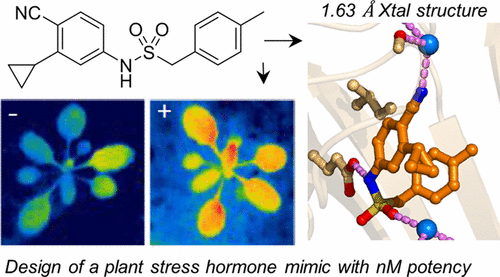当前位置:
X-MOL 学术
›
ACS Chem. Biol.
›
论文详情
Our official English website, www.x-mol.net, welcomes your
feedback! (Note: you will need to create a separate account there.)
A Rationally Designed Agonist Defines Subfamily IIIA Abscisic Acid Receptors As Critical Targets for Manipulating Transpiration
ACS Chemical Biology ( IF 3.5 ) Pub Date : 2017-10-18 00:00:00 , DOI: 10.1021/acschembio.7b00650 Aditya S. Vaidya 1 , Francis C. Peterson 2 , Dmitry Yarmolinsky 3 , Ebe Merilo 3 , Inge Verstraeten , Sang-Youl Park 1 , Dezi Elzinga 1 , Amita Kaundal 1 , Jonathan Helander 1 , Jorge Lozano-Juste , Masato Otani 1 , Kevin Wu 1 , Davin R. Jensen 2 , Hannes Kollist 3 , Brian F. Volkman 2 , Sean R. Cutler 1
ACS Chemical Biology ( IF 3.5 ) Pub Date : 2017-10-18 00:00:00 , DOI: 10.1021/acschembio.7b00650 Aditya S. Vaidya 1 , Francis C. Peterson 2 , Dmitry Yarmolinsky 3 , Ebe Merilo 3 , Inge Verstraeten , Sang-Youl Park 1 , Dezi Elzinga 1 , Amita Kaundal 1 , Jonathan Helander 1 , Jorge Lozano-Juste , Masato Otani 1 , Kevin Wu 1 , Davin R. Jensen 2 , Hannes Kollist 3 , Brian F. Volkman 2 , Sean R. Cutler 1
Affiliation

|
Increasing drought and diminishing freshwater supplies have stimulated interest in developing small molecules that can be used to control transpiration. Receptors for the plant hormone abscisic acid (ABA) have emerged as key targets for this application, because ABA controls the apertures of stomata, which in turn regulate transpiration. Here, we describe the rational design of cyanabactin, an ABA receptor agonist that preferentially activates Pyrabactin Resistance 1 (PYR1) with low nanomolar potency. A 1.63 Å X-ray crystallographic structure of cyanabactin in complex with PYR1 illustrates that cyanabactin’s arylnitrile mimics ABA’s cyclohexenone oxygen and engages the tryptophan lock, a key component required to stabilize activated receptors. Further, its sulfonamide and 4-methylbenzyl substructures mimic ABA’s carboxylate and C6 methyl groups, respectively. Isothermal titration calorimetry measurements show that cyanabactin’s compact structure provides ready access to high ligand efficiency on a relatively simple scaffold. Cyanabactin treatments reduce Arabidopsis whole-plant stomatal conductance and activate multiple ABA responses, demonstrating that its in vitro potency translates to ABA-like activity in vivo. Genetic analyses show that the effects of cyanabactin, and the previously identified agonist quinabactin, can be abolished by the genetic removal of PYR1 and PYL1, which form subclade A within the dimeric subfamily III receptors. Thus, cyanabactin is a potent and selective agonist with a wide spectrum of ABA-like activities that defines subfamily IIIA receptors as key target sites for manipulating transpiration.
中文翻译:

合理设计的激动剂将亚科IIIA脱落酸受体定义为操纵蒸腾的关键目标。
干旱的增加和淡水供应的减少激发了人们对开发可用于控制蒸腾作用的小分子的兴趣。植物激素脱落酸(ABA)的受体已成为该应用的关键目标,因为ABA控制气孔的孔径,进而调节蒸腾作用。在这里,我们描述了cyanabactin的合理设计,cyanabaactin是一种优先激活Pyrabactin抗性1的ABA受体激动剂。(PYR1)具有较低的纳摩尔浓度。氰基菌素与PYR1配合使用的1.63ÅX射线晶体结构表明,氰基菌素的芳腈模拟ABA的环己烯酮氧并与色氨酸键结合,而色氨酸键是稳定活化受体所需的关键组分。此外,其磺酰胺和4-甲基苄基亚结构分别模拟ABA的羧酸酯和C6甲基。等温滴定量热法的测量结果表明,氰基actin的紧凑结构可在相对简单的支架上立即获得高配体效率。氰尿素治疗降低拟南芥全植物气孔导度并激活多种ABA反应,表明其体外效价在体内转化为ABA样活性。。遗传分析表明,通过遗传去除PYR1和PYL1(在二聚体亚家族III受体内形成A子囊),可以消除氰基菌素和先前确定的激动剂喹阿布丁的作用。因此,氰基肌动蛋白是一种有效的选择性激动剂,具有广谱的ABA样活性,可将IIIA亚家族受体定义为操纵蒸腾作用的关键靶位点。
更新日期:2017-10-19
中文翻译:

合理设计的激动剂将亚科IIIA脱落酸受体定义为操纵蒸腾的关键目标。
干旱的增加和淡水供应的减少激发了人们对开发可用于控制蒸腾作用的小分子的兴趣。植物激素脱落酸(ABA)的受体已成为该应用的关键目标,因为ABA控制气孔的孔径,进而调节蒸腾作用。在这里,我们描述了cyanabactin的合理设计,cyanabaactin是一种优先激活Pyrabactin抗性1的ABA受体激动剂。(PYR1)具有较低的纳摩尔浓度。氰基菌素与PYR1配合使用的1.63ÅX射线晶体结构表明,氰基菌素的芳腈模拟ABA的环己烯酮氧并与色氨酸键结合,而色氨酸键是稳定活化受体所需的关键组分。此外,其磺酰胺和4-甲基苄基亚结构分别模拟ABA的羧酸酯和C6甲基。等温滴定量热法的测量结果表明,氰基actin的紧凑结构可在相对简单的支架上立即获得高配体效率。氰尿素治疗降低拟南芥全植物气孔导度并激活多种ABA反应,表明其体外效价在体内转化为ABA样活性。。遗传分析表明,通过遗传去除PYR1和PYL1(在二聚体亚家族III受体内形成A子囊),可以消除氰基菌素和先前确定的激动剂喹阿布丁的作用。因此,氰基肌动蛋白是一种有效的选择性激动剂,具有广谱的ABA样活性,可将IIIA亚家族受体定义为操纵蒸腾作用的关键靶位点。











































 京公网安备 11010802027423号
京公网安备 11010802027423号